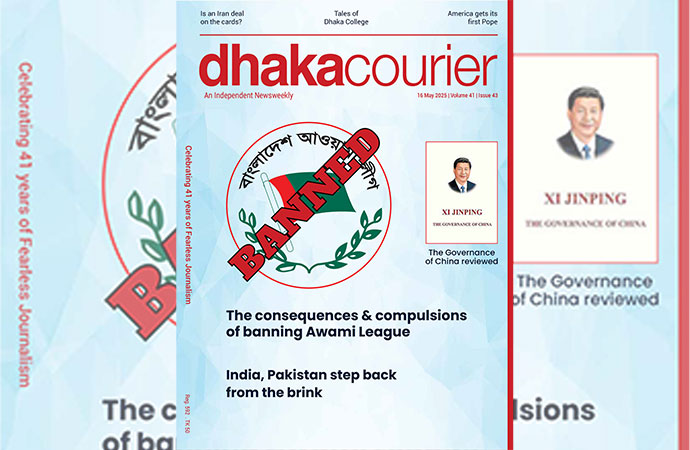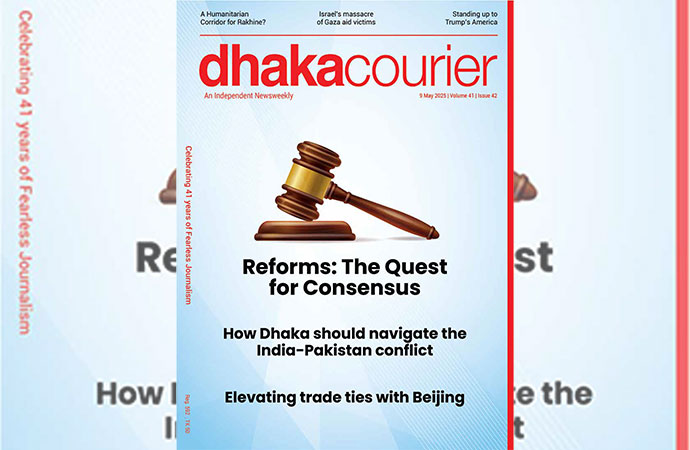Featured 2

Two women look at portraits of Princess Diana and other remembrances displayed on the gates of Kensington Palace, in London, Tuesday, Aug. 30, 2022. This week marks the 25th anniversary of Princess Diana's death in a Paris car crash. Photo: AP/UNB
Mary Queen of Scotts, married to the Dauphin of France, widowed less than 2 years later, was condemned by the firebrand Calvinist John Knox. Standing in front of the Judges minutes before her execution on February 8, 1587 the Dauphiness said -Remember that the theatre of the world is wider than the realm of England."
The tragic death of Princess Diana in a Parisian tunnel on Sunday 31st August 1997, catapulted the suggestion of Mary Queen of Scotts to a rarefied plane of credibility when Diana, the Princess of Wales, herself tried to explore the adventures of the wider world outside England, through love and compassion. A fairy tale out of the classics of the yore came true in the brutal reality of Paris when Diana, Tony Blair's People's princess," was crushed together with her companion Dodi-Al-Fayed. The French capital has an uncanny way of playing in the uncertain hours of chiaroscuro to be beholden to the pneumenal tryst with destiny. Prince Aly Khan hit his automobile at one-minute-past-midnight against a Parisian tree leaving Rita Hayworth and Princess Yasmeen to mourn his untimely death. Grace Kelly met her death in an accident which many of her admirers still cannot come to terms with.
Princess Diana's death is of course more dramatic than the others, giving an aura which is not connected with any happenstance of an ordinary life. She chose the wider world rather than the constricted atmosphere of the Establishment symbolized by Her Majesty the Queen. BBC Panorama interview on November 20, 1995' foreshadowed the life she was going to pursue and perhaps the fate she was going to meet. Her visit to Mother Teresa's Missionary of Charity in Calcutta or her mingling with the war victims of Angola, with grotesque and mangled ebony of a face-beautiful African child - represented her love for common people-truly demonstrated her rejection of the Establishment. She reached out to the needy and the distressed, the poor and the benighted. Together with Liz Taylor she electrified the people's mind against the scourge of Aids. The 20th century plague was to be contained and Diana took up the gauntlet with confidence and hope. Her visit to Bosnia in her anti-personnel mine campaign was perhaps, the finest expression of the determination to see a better world, a more humane world. She did not even hesitate to criticise the establishment around the globe for their pursuit of the policy of real-politic and some governments felt ruffled when she was found dabbling in politics. Tony Blair again came to stand by her for the real humanitarian work she was doing.
Diana was best known in Europe and America and some parts of Africa and Asia. In Asia, she visited Japan, Pakistan and India. A beautiful woman, she could find time to appreciate a beautiful creation away from the din and bustle of a Cancer Hospital or an HIV Institute, to go to a Japanese tea-ceremony or the Taj Mahal in Agra. A living legend, she could sell her customer-made gowns made by Ferragamo, Versace, Dior, or Oscar dela Renta.
or Chanel for over 4 million dollars. A versatile woman, she was easy with the poor and the common as she was comfortable in a minute or pas-de-trois: she thus challenged such icons as Joan of Ark or Evita. Never has any individual touched the hearts of so many in such a short time. Her most lasting legacy will be the success of the anti-personnel mine campaign. The 100-country conference in Oslo will perhaps put her name in the Hall of Fame by naming the Final document after Diana.
In the United States, Diana carried the Americans off their feet. Americans went Republican through their War of Independence in 1776 to reject anything to do with monarchy which always reminded them of their bloody War of Independence and two Roman Emperors- Nero and Caligula. The only other British woman who could leave a permanent mark in the American mind till the disappearance of Diana,the Princess of Wales, was lady Victoria Sackville, the daughter of Pepita, the Spanish dancer and Lionel Sackville-West, the distinguished British diplomat, who was specially despatched to Washington in 1881, when 3 to 4 major problems were bedevilling US-GB relations and when Washington was still considered a hardship posting for the British diplomats and above all, at a time when the British only had a legation in Washington (elevated as an Embassy only in 1893). Washington could not compare in importance to big European Embassies in Paris, Rome, Vienna, or St. Petersburg. Coming to Washington following Sir Edward-Thomson, Sackville-West's success in improving Anglo-US relations was almost entirely due to this lady, remarkable Lady, Sackville, her courage and character, whom the Washington society called the 'Shy ingenue'. Secretary of State Blaine and President Arthur were both taken to her beauty and charm: President Arthur even proposed to marry her-an offer promptly rebuffed with charm and alacrity.
History tells us that Diana was perhaps the only other lady the second-in the past hundred years who could have won over the American mind in as much as the 'shy ingenue' did in Washington. The tremendous reception given to Diana by the American socialites from coast to coast as the 'diva' from the albion's distant shore, came at a time when the US-UK relations were not at its best with John Major toiling hard to restore a semblance of the 'special relationship ' that MargaretThatcher forged with the Reagan-Bush duo. Diana's `Debutante Ball' in the US received raving acclamation as the best in recent memory.
The Clinton's red-carpet welcome given to the Princess of Wales was reminiscent of the days of Lady Sackville in the Washington scene or the camelot of John Kennedy. But times are different and so are the mise-en-scenes. Tributes paid to the people's princess by Clinton or Hashimoto, Gujral or Nelson Mandela and Prime Minister Sheikh Hasina or Benazir Bhutto were almost identical in their tenor and resonance.
Queen consort of Henry VIII, Anne Boleyn, (mother of Elizabeth I) was condemned to death because of alleged adultery and executed. Henry's first marriage to Catherine of Aragon was declared invalid. Anne Boleyn lost favour with the king in only 1000 days because of the birth of a daughter (future Queen Elizabeth I), a miscarriage and a stillborn son. The Duke of Windsor married Mrs. Simpson and abdicated the British throne. Princess Margaret, number 4 in line of accession was refused permission to marry Peter Townsend - the man she loved. The Princess abided by the Palace rule but her self-abnegation won over the hearts of millions of her admirers. the untold suffering of woman through The Roman Holiday- a movie still considered a classic.
Brought up in the royal ambiance of the Spencers of which Barbara Cartland was a noted member, the princess tried her best in following the royal etiquette.
But the appearance of Camilla Bowles Parker in their life was too much for her to accept-it was the last straw in the camel's back. Giving an interview in the popular Roman tabloid" La Republica" Barbara Cartland truly suggested 'nobody can fill in the place of Diana in the Royal family'. With the diminishing popularity of the House of Windsor Diana stood alone in not only transmitting message to the world on the necessity of Royalty but also sustaining its raison d'etre, but only in the perspective of the present day reality. She did not want the British royalty to go cycling as the Scandinavians do. She urged upon the House of Windsor to take note of the changed popular mood and very subtly communicated 'adaptor perish'. The universal show of respect to the girl from the House of Spencers was aptly reflected in the lowering of the Union Jack on the Buckingham Palace with the full consent of the Queen an event of historic significance.
It was almost revolutionary; the House of Windsor responded to the popular mood, in England and the world at large. It was a concession of tremendous significance - maybe this will be both a safety-valve and a signal for a new direction. The Queen has handled the crisis with deftness and dexterity. She is the symbol in the continuum of the British Monarchy, she also epitomises the Establishment The British have long left behind the Wars of the Roses or their brief affair with Cromwellian republicanism.
Earl Spencer's tribute to his sister Diana in the West Minster Abbey on Saturday, September 6, just made the point. Emotions apart, his sweep over history -today and yesterday was listened to with care and understanding. Predictably, he put the blame on the House of Windsor for Diana's untimely death. Diana was not given her due as HRH in the palace. She was asked to be conformist to follow the Victorian Comportment.
That was the fatal blunder of the palace. While Elton John's Candle in the Night with Lord Spencer's funeral oration brought tears in the viewers' eyes throughout the world, Tony Blair acted swiftly in assisting the Queen in damage control, an Oxonian touch was much too visible and rightly so. For the Asians, there was reaction of another kind: The hesitant Establishment reminded them of the perfidy of Lord Clive, the corruption of Warren Hastings, Lawrence of Arabia's misdemeanour with Afghanistan's King Amanullah, General Dayer's massacre at Jallianwala Bagh or Lord Wellesley's rivalry over the corpse of valiant Tipu Sultan.
These are memories, but memories set in perspective, the state of relations between nations. And thanks to Diana, the Princess of Wales, for triggering off the precious trend of equilibrium unwittingly in death, between the British Royalty and the British people and the world at large. And this would be her most lasting contribution to a People that was still not reconciled with the reality of the lost Empire the omphalos of the Empire.
Author of Forgotten War Forgotten Genocide. Email- wali.heritage@gmail.com

























Leave a Comment
Recent Posts
Rare folk treasures at risk in ...
Amid the quiet greenery of Ulipur upazila in Kurigram, a humble tin-ro ...
Enayetullah Khan to represent ...
Enayetullah Khan, Editor-in-Chief of United News of Bangladesh (UNB), ...
The tragedy in Ahmedabad touches us all
Asset recovery a key focus; breakthroughs from talks ..
'It'll inspire youths to build Bangladesh they dream ..
UK envoy Sarah Cooke happy with Yunus’ visit to Brit ..